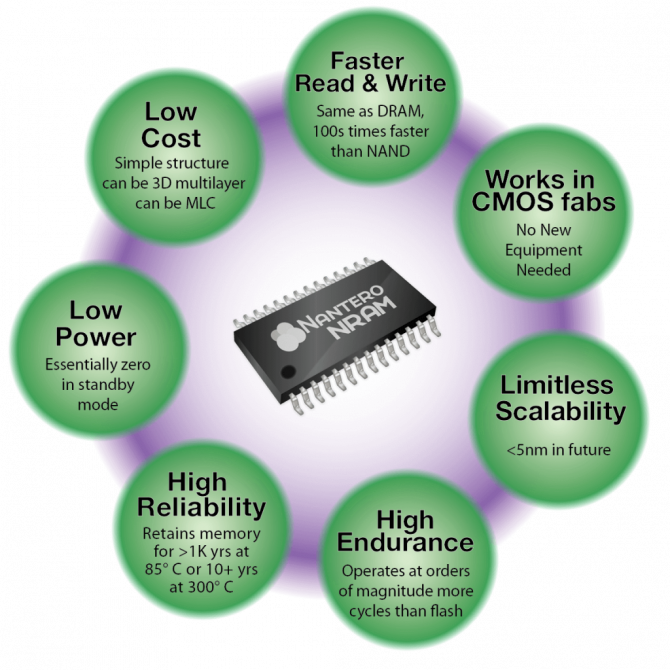During Hot Chips 2018, American company Nantero provided more information about its new storage technology called Nanotube RAM (NRAM). The technology has passed all tests for mass production and could be used as a non-volatile alternative to DRAM DDR4 modules, the company claims.

Development of the carbon nanotube (CNT) storage technology started about seventeen years ago, and we also reported about it in 2016 when Nantero also issued a press release that it's technology was ready for production in System on a Chips (SoCs). Back then the company announced 256 Mbit chips and that Fujitsu would be a launch partner in 2018.
At this year's Hot Chips conference, the start-up announced production readiness of its NRAM in larger capacities and claims the chips should become available next year.
The memory cells are based on carbon nanotubes on a substrate that are controlled through electrostatic pulses. Nanotubes are placed between two electrodes and depending on whether the tubes are crossed, the resistance changes, which can be measured. Through measuring the resistance, two different states can be measured. When the tubes don't connect, resistance is high which represents a '1'. When the tubes connect, resistance is low which represents a 'o'. These states are the basic requirements of a memory cell.
Nantero claims there are several advantages over DRAM memory. CNT cells should be more resilient and durable. Nantero states a life expectancy of over 10,000 years at room temperature. Performance should be similar to DDR4 SDRAM. And due to that performance combined with the non-volatility, it highly competitive to 3D XPoint and NAND Flash memory.
Fujitsu also this time announced it wants to bring NRAM memory to the mass market. It's not entirely sure when that will be, as Nantero is currently looking into elimination of difficulties in the production of NRAM. We'll have to see whether Fujitsu's 2016 goal of bringing 256Mbit (32 MB) chips to the market in 2018 will be achieved.
Nantero considers itself the ARM of memory, which means it will sell the design of the chips, but won't actually produce it. Currently the company has the design ready of 8Gb and 16Gb chips that are manufactured on a 28nm process and have 2 or 4 layers respectively. Ultimately, the company hopes to scale to 8 layered 512Gb chips manufactured at 7nm, but this could take many years.
The first NRAM chips will be single level cell/ one bit per cell (SLC) but the company is looking into multi level cell / two bits per cell (MLC) similar to NAND technology. While it's non-volatility would make it an excellent NAND Flash competitor, it's currently not. NAND flash capacity is already at 1 Terabit per die, NRAM starts with only 8 Gigabits per die.
Therefore, it will likely first compete with the volatile DRAM, with the benefit that memory remains when power is turned off or lost and Nantero also claims its technology is cheaper. Another possibility would be a caching disk, where frequently accessed data would be stored to speed up the system, similar to how Intel brought 3D Xpoint to the market, with Optane caching drives.
















